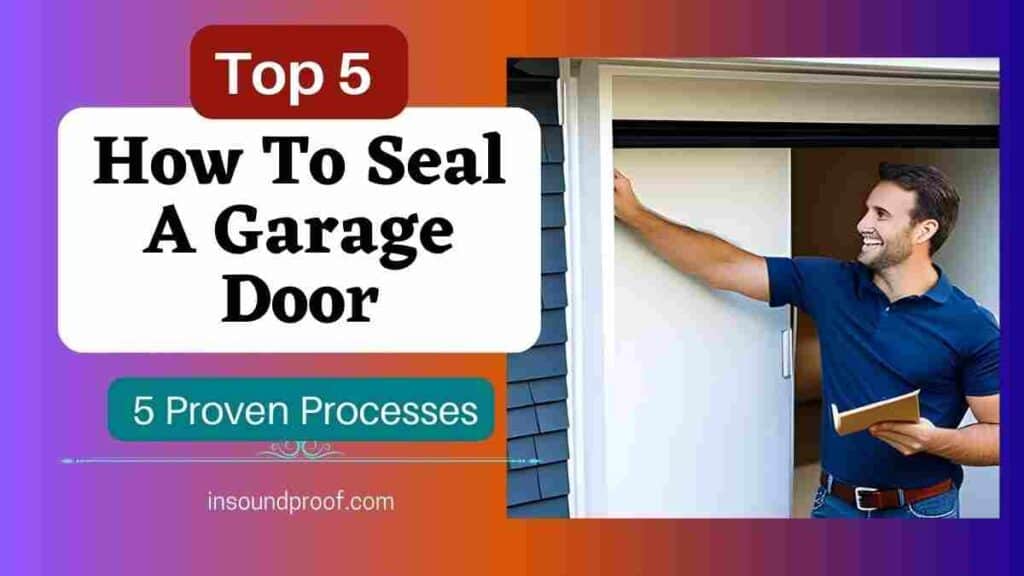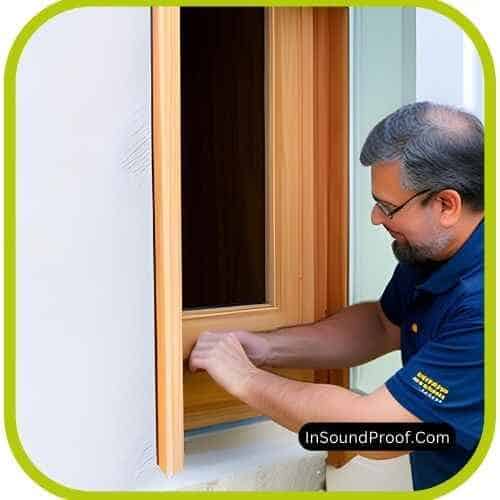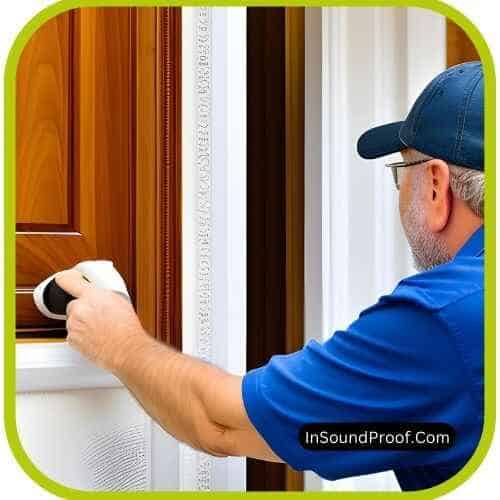As a homeowner, one of the important tasks you need to undertake is ensuring that your garage door is properly sealed.
A properly sealed garage door not only prevents pests and debris from entering your garage but also helps to regulate the temperature in your garage, which can help to reduce your energy bills.
Moreover, you can enjoy a noise-free environment by just ensuring that your garage door is properly sealed. How cool is that!
In this article, I will provide you with a step-by-step guide on how to seal a garage door.
Replace damaged weather stripping to seal your garage door effectively. This acts as a barrier between the door and the frame.
For a new door, check for gaps between the door and frame and seal them with weatherstripping or caulking. Once applied, your door should stay sealed until it’s time to replace it.
Related: Best 15 Ideas to Soundproof a Garage Without Investing Lots of Money.

Table of Contents
Importance of Sealing Your Garage Door
Sealing your garage door is important for several reasons.
One of the key reasons is that it helps to keep pests and debris out of your garage. This is particularly important if you use your garage as a storage space.
Pests such as rodents and insects can cause damage to your belongings, and debris can make your garage look untidy and cluttered.
Another reason why sealing your garage door is important is that it helps to regulate the temperature in your garage.
If your garage is not properly sealed, it can become too hot in the summer and too cold in the winter. This can make it uncomfortable to work in your garage, and it can also increase your energy bills as you may need to use heating or cooling devices to regulate the temperature.
Related: Soundproof Home Office Pods for a noise-free environment.
How To Seal A Garage Door
Preparing The Garage Door For Sealing
To ensure that your garage door is properly sealed, you will need to prepare it before you start sealing.
- The first step in how to seal a garage door is to clean the garage door thoroughly using soap and water. This will help to remove any dirt, dust, or debris that may be on the garage door.
- Once the garage door is clean, you will need to inspect it for any gaps or holes.
- You can do this by running your hand along the edges of the garage door and feeling for any gaps.
- You can also inspect the garage door for any visible gaps or holes. If you find any gaps or holes, you will need to seal them using silicone caulk.
Related: Best 15 Methods to Soundproof Barn Door Yourself.
Common Ways to Seal A Garage Door
It is important to keep your garage door sealed in order to protect your home from the elements and unwanted pests. There are several ways to go about sealing a garage door, each with its own advantages and disadvantages.
Let’s take a look at the five most common ways to seal a garage door.
- One way you can seal a garage door is by using weatherstripping. These is generally strips of plastic or rubber that are attached to the sides and bottom of the garage door. This creates an airtight seal when the door is shut and it also reduces noise from entering or exiting through the garage. The downside to this method is that it may need to be replaced over time if the weatherstripping becomes damaged or worn out by age.
- Another popular approach for sealing a garage door is with caulk or sealant. Depending on the type of product you use, this has the potential to last 5-10 years before needing to be replaced if it remains in good condition. This process involves applying either caulk or sealant around where two materials meet, such as between where two frames join together on a sectional-style door, and around any hardware on the outside surfaces of your garage door. The advantage of using a caulk or sealant is that you are able to maintain an airtight barrier around these points without having to worry about regular maintenance and replacements like weatherstripping.
- Another option for sealing a garage door is using a threshold seal kit. This kit includes a rubber seal that attaches to the bottom of your garage door, creating an airtight barrier between your house and the outside elements. It also helps reduce noise levels inside your home while providing an extra layer of security against intruders. Threshold seal kits can be purchased at most hardware stores and come with easy-to-follow instructions for installation. They do require some extra effort when installing but should last for many years with minimal maintenance required.
Related: 07 Effective Ways to Soundproof French Doors
How To Seal The Garage Door Sides

The sides of the door are sealed with either a foam gasket, foam tape, or sealant.
The foam gasket acts as a cushion between the door and frame and helps to keep out the elements. It usually comes with mounting holes that you can use to attach directly to your garage frame.
You then press it into place, making sure it is properly fitted and sealed along all sides.
Foam tape also provides a good seal as well as insulation, while sealant or caulk is used to fill any gaps or cracks in the frames.
Finally, you can add weatherstripping or a garage door threshold seal around the designated opening between the door and frame and seal them with weatherstripping or caulking.
Weatherstripping is available in various sizes and materials, such as foam and rubber.
You will need to measure the sides of your door
One of the most important areas to seal on your garage door is the sides.
To seal the garage door sides, you will need to apply weatherstripping along the edges of the garage door.
To do this, measure the length of the sides of the garage door and cut the weatherstripping to size using a utility knife.
Next, apply the weatherstripping along the edges of the garage door using a caulking gun.
Related: 10 Best Soundproof Office Pods That are Revolutionizing the Workplace
How To Seal The Garage Door Top
After all the steps you took to seal the sides of your garage door, it is important to do the same for the top. Sealing the top of your garage door helps to prevent water from entering in and can also reduce noise from outside.
The seal around the top of your door works by preventing air and moisture from entering in between the door and the frame. It not only helps to insulate and soundproof, but it also provides a barrier against the elements. It helps keep out dust, pests, and other debris as well as providing an extra layer of insulation during cold winter months. The seal helps provide a tight fit around the top of your door creating a watertight barrier.
To seal the top of your garage door, you will need a good-quality weatherstrip and some silicone sealant or caulk.
Start by measuring the length of the top side of your door then cut a piece of weatherstripping to fit that length. Smooth it out with a utility knife, then secure it in place with a caulking gun.
Then apply a bead of silicone sealant or caulk in any gaps around your weatherstrip, making sure everything is adequately sealed.
You’re almost there! To make your garage airtight and free from pesky drafts, all you need to do is install a garage door threshold seal! Once it’s in place, make sure to wipe away any extra sealant or caulk with a damp cloth and let it dry.
A garage door threshold seal is a strip of rubber that is installed along the bottom edge of the garage door. This helps to create a seal between the garage door and the floor.
To install the threshold seal, measure the width of the garage door and cut the seal to size using a utility knife.
Next, attach the seal to the bottom edge of the garage door using screws.
Related: How to Make Window Soundproof in 4 Easy Steps
How To Seal The Garage Door Bottom

Sealing the bottom of your garage door helps to prevent water from entering in and can also reduce noise from outside. This will reduce energy costs since it helps keep cold air out during the winter months.
To seal the garage door bottom, you will need to install a garage door sealant.
Garage door sealant is a type of adhesive that is applied to the bottom edge of the garage door. This helps to create a seal between the garage door and the floor.
To apply the sealant, clean the bottom edge of the garage door thoroughly using soap and water.
Next, apply the sealant to the bottom edge of the garage door using a caulking gun. Make sure to cover the entire edge with an even coat and extend slightly past either side of the garage door.
Allow the sealant to dry thoroughly before closing the garage door.
Soundproofing: You can Soundproof Sliding Doors yourself.
How To Seal Gaps
If you find any gaps or holes in your garage door, you will need to seal them using a silicone caulk. Silicone caulk is a type of adhesive that is applied to gaps and holes to seal them.
To apply the caulk, clean the area around the gap or hole thoroughly using soap and water.
Next, apply the caulk to the gap or hole using a caulking gun. Smooth the caulk using a putty knife and allow it to dry according to the manufacturer’s instructions.
Other Ways to Seal Gaps:
In addition to silicone caulk, you can also seal gaps and holes with expanding foam.
Expanding foam is a type of spray foam that expands as it dries. This helps to fill in gaps and holes and create a better seal.
To apply the foam, simply spray it into the gap or hole and allow it to dry according to the manufacturer’s instructions.
How To Permanently Seal A Garage Door
If you want to permanently seal your garage door, you can install a garage door insulation kit.
A garage door insulation kit is a type of kit that is installed on the inner surface of the garage door. This helps to create a barrier between the garage and the outside environment.
This kit gets installed on the inside surface of your garage door and creates a barrier that keeps the outside environment where it belongs – outside!
You won’t believe how much warmer your garage will be in the winter and cooler in the summer. It’s like having a whole new room in your house!
The best part is that these kits are easy to install if you follow the manufacturer’s instructions carefully.
Other Ways to Permanently Seal A Garage Door:
In addition to installing a garage door insulation kit, you can also use weather stripping around the edge of the door. Weather stripping helps to create an air-tight seal around the door.
This helps to prevent warm and cold air from entering and exiting your garage, making it much more energy efficient.
It’s important to measure the size of your garage door before you purchase weather stripping so that you get the right fit.
Related: 5 Best Soundproof Sliding Glass Doors
Maintenance Tips For A Sealed Garage Door
To ensure that your sealed garage door lasts for a long time, you will need to perform regular maintenance.
Some of the maintenance tasks you can perform include cleaning the garage door regularly, inspecting the garage door for any damage, and lubricating the moving parts of the garage door.
How To Replace A Garage Door Seal
Over time, your garage door seal may become worn out and need to be replaced.
To replace the garage door seal, you will need to remove the old seal using a utility knife.
Next, measure the length of the garage door and cut the new seal to size using a utility knife.
Finally, attach the new seal to the bottom edge of the garage door using screws.
Common Mistakes To Avoid When Sealing A Garage Door
When sealing your garage door, there are some common mistakes you should avoid.
One of the most common mistakes is using the wrong type of sealant. Make sure to use a sealant that is designed for garage doors.
Another mistake to avoid is not cleaning the garage door thoroughly before applying the sealant.
Make sure to clean the garage door thoroughly to ensure that the sealant adheres properly.
Conclusion
Sealing your garage door is an important task that can help to keep pests and debris out of your garage, regulate the temperature in your garage, and reduce your energy bills.
By following the steps outlined in this article, you can seal your garage door effectively and efficiently.
If you have any questions or need further assistance, please feel free to contact us.
12 FAQs on How To Seal A Garage Door
Q1: How do I seal the gap under my garage door?
Ans: To seal the gap under your garage door, you can use a foam weather-stripping seal or a heavy-duty gravel sealant.
Q2: How often should I lubricate my garage door?
Ans: It is recommended to lubricate your garage door about every 3 to 6 months. Make sure to use a lubricant designed for garage door maintenance.
Q3: Should a garage door be completely sealed?
Ans: Yes, it is essential to seal your garage door completely to prevent pests, dirt, and debris from entering your garage and reduce your energy bills.
Q4: How do I seal my garage door from mice?
Ans: To prevent mice from entering, you may want to place wool insulating material along the bottom of the door, as well as wire mesh over all vents and openings. Additionally, you can apply rodent-proof sealant around your door.
Q5: How do you seal the bottom of a garage door with an uneven floor?
Ans: For an uneven floor, you should use a sealant that is designed to flex and move with the door. Additionally, you can use foam or Wool Insulation material to help fill any gaps.
Q6: What can I put under the door to fill the gap?
Ans: You can use a foam weather stripping seal or a heavy-duty gravel sealant to seal the gap under the door. Additionally, you can use insulation wool material or rubber cones to fill any larger gaps.
Q7: Should I caulk around the garage door?
Ans: Yes, you should use a sealant specifically designed for your garage door around all of the joints or seams between the door and the walls or floor. This will help to further prevent dirt, debris, and rodents from entering your garage and save energy.
Q8: How do I keep rodents out of my garage door?
Ans: The best way to prevent rodents from entering your garage is to seal any gaps, cracks, or seams between the door and the walls or floor. Additionally, you can apply rodent-proof sealant along the bottom of the door and place wire mesh over all vents and openings.
Q9: What goes at the bottom of a garage door seal?
Ans: Wool Insulation material, rubber cones, and heavy-duty gravel sealant go at the bottom of a garage door seal. Additionally, you can use a foam weather stripping seal for an extra layer of protection.
Q10: How to seal a garage door to make a room?
Ans: To make a room out of your garage, start by sealing up any cracks or gaps between the door and the walls or floor with a sealant specifically designed for garage doors. Additionally, you can lay down flooring and add insulation to make the room comfortable. Finally, you will want to install interior doors and windows for ventilation, light, and safe access.
Q11: What is the best caulk for garage door seal?
Ans: The best caulk for a garage door seal is silicone caulk. It is highly flexible and can withstand extreme temperatures, making it a great choice for both hot and cold climates. Additionally, it is water-resistant, so it will help to keep unwanted moisture out of your garage.
Q12: How do I know what garage door seal I need?
Ans: For larger gaps, use insulation wool material or heavy-duty gravel seal. For smaller gaps, use a foam weather stripping seal or rubber cones. You should also consider any additional weatherproofing needs for your specific climate.


